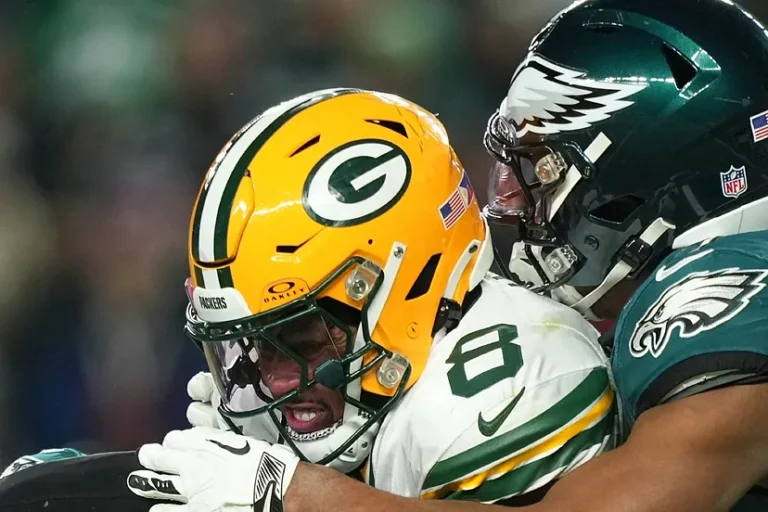The NFL is no stranger to rule changes and the debates that follow them. From changes to the kickoff rules to modifications around what constitutes a catch, the league has always sought to adjust its regulations to ensure the game is both competitive and safe. However, the recent proposal to ban the “tush push” has sparked a fresh wave of discussion, one that’s dividing fans, players, and analysts alike. This rule, which has become increasingly popular in recent seasons, has been labeled as controversial by some—and while the Green Bay Packers and their fans may have a different perspective, the NFL’s decision could impact the way the game is played for years to come.
### What is the ‘Tush Push’?
Before diving into the debate surrounding the proposal, it’s important to understand exactly what the “tush push” is. The term refers to a play in which the quarterback, typically in short-yardage or goal-line situations, is pushed from behind by a teammate or teammates to help gain extra yardage. It’s a variation of the quarterback sneak, with the key difference being the assist from a pushing player.
The play became popularized by the Philadelphia Eagles in recent years, especially with the leadership of quarterback Jalen Hurts. The Eagles have perfected the technique to such a degree that it has become nearly unstoppable in short-yardage situations. The strategy often involves a tight formation, with the quarterback crouching behind the center and the offensive line sealing off defenders. The running back or another offensive player then gives the quarterback a push from behind, helping him cross the necessary yardage for a first down or touchdown.
What’s made the play so effective—and, according to some, so controversial—is how difficult it is to defend. In short-yardage situations, when the offense has only a few inches to gain, the tush push becomes nearly unstoppable when executed properly. The Eagles’ success with the play has led to increasing calls to ban or modify it, particularly from teams that have struggled to stop it.
### Packers Push Back
For the Green Bay Packers, the proposal to ban the tush push hits particularly close to home. As a team with a storied history of both offensive and defensive success, the Packers are no strangers to adapting to new tactics in the NFL. However, their pushback against the potential ban of the play stems from both practical and philosophical concerns.
On the practical side, the Packers’ defense has faced the tush push in some of their most challenging games. In a league where every inch matters, the ability to stop such a powerful play could mean the difference between winning and losing. And despite their best efforts, the Packers have often struggled to shut down the play when facing off against teams like the Eagles, which only highlights how effective the tush push can be. While this has led to criticism of their defense, it also presents the larger issue: if the play is banned, would it really solve the problem, or would it simply force teams to find other equally difficult-to-defend tactics?
From a philosophical standpoint, the Packers have long been proponents of a physical style of play. The concept of the “tush push” aligns with the hard-nosed, run-first approach that has made teams like the Packers and their NFC North rivals so successful over the years. To ban a play that rewards physicality seems to go against the grain of the NFL’s tradition—where power football and tough, hard-fought yards have always had a place. The Packers are, at their core, a team that values strategy, adaptability, and skill. They believe that rather than eliminating the play, teams should be tasked with figuring out how to stop it, as they would with any other offensive strategy.
### The NFL Debate: Is the Tush Push Unstoppable?
The argument for banning the tush push centers around its perceived unfair advantage. Opponents of the play argue that it gives teams like the Eagles a significant edge in short-yardage situations, making it nearly impossible for the defense to stop. Some coaches and analysts believe that the play undermines the competitive balance of the game, as it can be executed with minimal risk and is difficult to defend, even with the best defensive lines. Additionally, critics contend that the play is a direct result of the NFL’s current rules regarding pushing the ball carrier, which allows for assistance in specific situations.
One of the primary concerns is player safety. The “tush push” involves a high degree of physical contact, with multiple players engaging in pushing and shoving. While proponents argue that the play is no more dangerous than any other type of short-yardage or goal-line situation, the increased physicality of the move has raised alarms. With players being driven into piles of bodies in such a concentrated manner, the risk of injury—particularly to the lower body—has become a key point of concern for safety-conscious advocates.
On the flip side, those who support the continuation of the tush push argue that it’s simply a product of innovation and strategy. In a league where teams are constantly searching for ways to gain an advantage, the ability to execute a well-designed and well-timed play should not be penalized. Just as the forward pass changed the dynamics of the game years ago, the tush push is viewed as another strategic evolution that teams should be allowed to utilize. These supporters emphasize that it’s not the play itself that’s the problem, but rather the need for defenses to adapt and find a way to stop it.
### The Future of the Play
As the debate continues, one thing is clear: the future of the tush push could significantly alter the way teams approach short-yardage situations. If the proposal to ban the play passes, it will force teams to find new ways to convert on critical third-and-short or fourth-and-short situations. Some analysts have suggested that without the tush push, teams may return to more traditional quarterback sneaks or begin utilizing different offensive schemes in these moments.
However, if the tush push remains a legal play, teams will likely continue to perfect and adapt it in order to gain an edge. As is the case with any successful strategy in the NFL, once a play is proven to be effective, teams across the league will begin to incorporate it into their own playbooks. This could lead to a wider adoption of the play, with many teams following the lead of the Eagles and employing the tush push as a staple in their short-yardage game plan.
### Conclusion: A Divisive Issue
The NFL’s ongoing debate over the tush push highlights the delicate balance between innovation and tradition. While the Packers may push back against the proposal, believing in the integrity of physical football, others view the play as an unfair advantage that disrupts competitive balance. The NFL’s decision on whether to ban the play will have lasting implications, not only for the Packers but for teams across the league.
In the end, this debate encapsulates the evolving nature of football, where every advantage—no matter how small—can become a point of contention. Whether or not the tush push remains a part of the game, the larger conversation it sparks about strategy, physicality, and fairness will continue to shape the future of the NFL. For now, the Packers, along with other teams, will continue to find ways to adapt, whether that means perfecting their defensive strategies or pushing back against proposals they feel could undermine the spirit of the game



